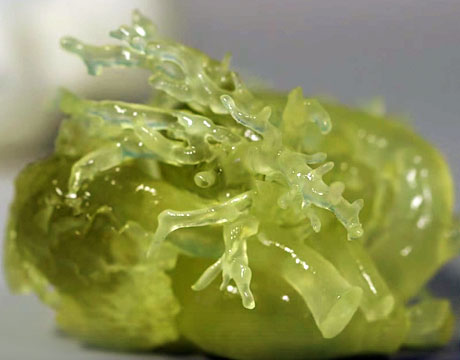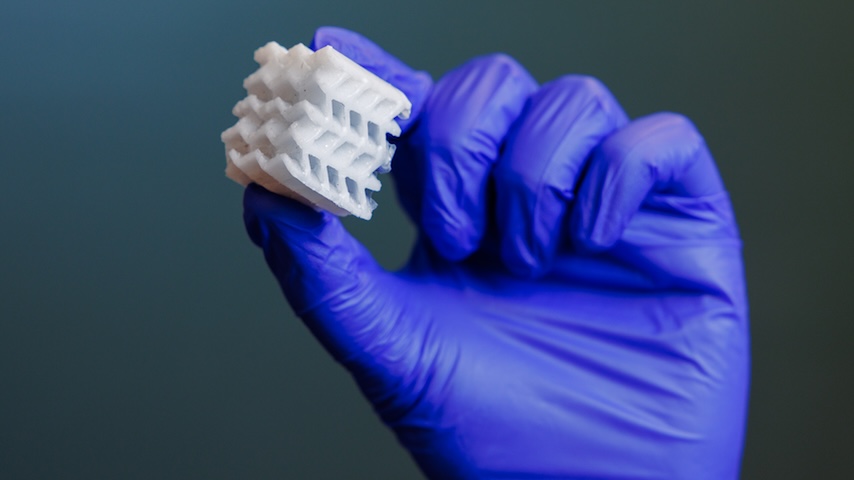How 3D Printing Saves Lives
How 3D Printing Saves Lives


Soft, flexible forms are printed for situations where anatomy needs to be distorted. Image: Texas Children’s Hospital
3D printing is typically viewed as an industrial breakthrough for the way it is revolutionizing manufacturing, the supply chain, and operations. It is, however, also being used in very creative ways to improve health and longevity. From 3D surgical models and implants, to training and rescue, to the 3D printing of nutritious food for hungry populations, 3D printing is saving lives around the world.
Medical Applications
One of the most useful applications of 3D printing in healthcare is producing a detailed product or prototype from a CAD file or other form of electronic data. Using a CT scan or MRI, surgeons can now print an exact replica of an organ or particular area of the body. This allows surgeons to identify potential problems before undertaking surgery and plan and/or practice a specific procedure, improving patient outcomes and reducing overall surgery time.
“Having a 3D printed model gives you insight into what you’re going to encounter,” says Dr. Rajesh Krishnamurthy, chief of radiology research and cardiac imaging at Texas Children’s Hospital, who used 3D printed models of intertwined organs for separation surgery of conjoined twins.
3D printing is also used to manufacture customized implants and prosthetics. For example, neurosurgeons in Australia recently replaced a cancerous bone with a titanium 3D printed vertebrae, the first of its kind in the world. 3D printing is also an effective tool for making patient-specific replacement joints and spacers. The prosthetic limbs that most people can afford are typically generic, which often compromises fit and function. Customized, more functional prosthetics are much more expensive. Now, with 3D printing, customized prosthetic limbs can be made at much lower cost, providing the wearer greater function, comfort, and a higher quality of life..
Perhaps one of the most innovative uses of 3D printing is the construction of artificial skin. A patient’s skin cells, combined with polymers, can be 3D printed in sheets to produce a synthetic skin for covering wounds or burns. In fact, the synthetic skin can be printed directly onto the injury to save time and reduce the risk of infection. 3D printing of artificial skin also eliminates the need for skin graft operations. Researchers are developing portable bioprinting systems that will be able to produce artificial skin on the battlefield or in rural areas, where medical services are limited.
Training and Rescue
Natural disasters, especially flooding, are one of the top killers of people around the world. Heavy rains also trigger landslides, which can devastate entire communities. Regional and national governments are using 3D printing to prepare for flooding and landslides in high-risk areas. For example, in some Andean communities, government leaders and scientists have created 3D printed models of the mountainous terrain to determine which areas are the most vulnerable to disaster, and to create response plans accordingly.
Another limitation in many rural or impoverished areas that are prone to flooding is lack of real-time weather measurements and the timely communication of alerts and warnings. Many flood-prone countries cannot afford expensive weather systems to properly monitor the weather. In response, theUnited States Agency for International Development(USAID) and the National Oceanic and Atmospheric Administration have partnered to help develop low-cost 3D printers that can make reliable, accurate weather stations for around $200.
“The bottom line is that 3D printing will help to save lives,” says Sezin Tokar, senior hydrometeorological hazard advisor at USAID. “Not only can these 3D printed stations provide countries with the ability to more accurately monitor for weather-related disasters, the data they produce can also help reduce the economic impact of disasters.”
For EMTs and first responders who venture into disaster areas, 3D printing can enhance their life-saving skills. Using 3D printing, the University of Minnesota has created highly realistic training mannequins that even bleed. Officials at the University of Minnesota’s Simulation PeriOperative Resources for Training and Learning (SimPORTAL) plan to develop increasingly complex simulated human models that will help more effectively train military medics, civilian EMTs, and other first responders across a wider range of physiological trauma situations. “We want to give them the most lifelike experience possible before they get that experience in real life,” indicates Dr. Robert Sweet, associate professor of urology and director of SimPORTAL.
Feeding the World
3D printing is also being explored as a way to create food for victims of natural disasters or famine. Food ingredients and components can be 3D printed into food products that are easy to wrap and ship, or that can be 3D printed on site at the disaster area. Foods can be printed to meet specific requirements, such as calorie count and nutritional content..
"People all over the world cannot afford basic food ingredients,” says Anjan Contractor, a 3D printing expert and founder of BeeHex, a start-up that won a $125,000 grant from NASA to create a 3D printer that can print food for astronauts on deep-space missions. “In India, for example, the price of onions—something small, like onions—is too high for most people to afford. Now, imagine if food could be printed. You control nutritional value. You make healthy eating available for everyone. There are people in the world that can't afford food, and 3D printing can change that.".
Mark Crawford is an independent writer.
Learn more about the latest technologies in 3D printing at ASME’sAM3D Conference & Expo.
From 3D surgical models and implants, to training and rescue, to the 3D printing of nutritious food for hungry populations, 3D printing is saving lives around the world.





